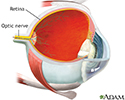Neuroretinitis
Neuroretinitis is inflammation of the retina and optic nerve of the eye. The condition can be caused by bacteria, viruses or autoimmune disease. It shares some features of optic neuritis. There is mostly central visual loss, which often recovers after some months, but often not completely.
Retina
The retina is the light-sensitive layer of tissue at the back of the eyeball. Images that come through the eye's lens are focused on the retina. Th...

There is no treatment that has proven to be helpful.
References
Purin V, Glaser JS. Topical diagnosis: pre-chiasmal visual pathways. In: Tasman W, Jaeger EA, eds. Duane's Ophthalmology . Philadelphia, PA: Lippincott Williams & Wilkins; 2013:vol 2;chap 5.
Yanoff M, Cameron D. Diseases of the visual system In: Goldman L, Schafer AI, eds. Goldman's Cecil Medicine . 25th ed. Philadelphia, PA: Elsevier Saunders; 2016:chap 423.
-
Eye - illustration
The eye is the organ of sight, a nearly spherical hollow globe filled with fluids (humors). The outer layer or tunic (sclera, or white, and cornea) is fibrous and protective. The middle tunic layer (choroid, ciliary body and the iris) is vascular. The innermost layer (the retina) is nervous or sensory. The fluids in the eye are divided by the lens into the vitreous humor (behind the lens) and the aqueous humor (in front of the lens). The lens itself is flexible and suspended by ligaments which allow it to change shape to focus light on the retina, which is composed of sensory neurons.
Eye
illustration
-
Retina - illustration
The retina is the internal layer of the eye that receives and transmits focused images. The retina is normally red due to its rich blood supply.
Retina
illustration
-
Eye - illustration
The eye is the organ of sight, a nearly spherical hollow globe filled with fluids (humors). The outer layer or tunic (sclera, or white, and cornea) is fibrous and protective. The middle tunic layer (choroid, ciliary body and the iris) is vascular. The innermost layer (the retina) is nervous or sensory. The fluids in the eye are divided by the lens into the vitreous humor (behind the lens) and the aqueous humor (in front of the lens). The lens itself is flexible and suspended by ligaments which allow it to change shape to focus light on the retina, which is composed of sensory neurons.
Eye
illustration
-
Retina - illustration
The retina is the internal layer of the eye that receives and transmits focused images. The retina is normally red due to its rich blood supply.
Retina
illustration
Review Date: 11/4/2015
Reviewed By: Franklin W. Lusby, MD, ophthalmologist, Lusby Vision Institute, La Jolla, CA. Also reviewed by David Zieve, MD, MHA, Isla Ogilvie, PhD, and the A.D.A.M. Editorial team.


